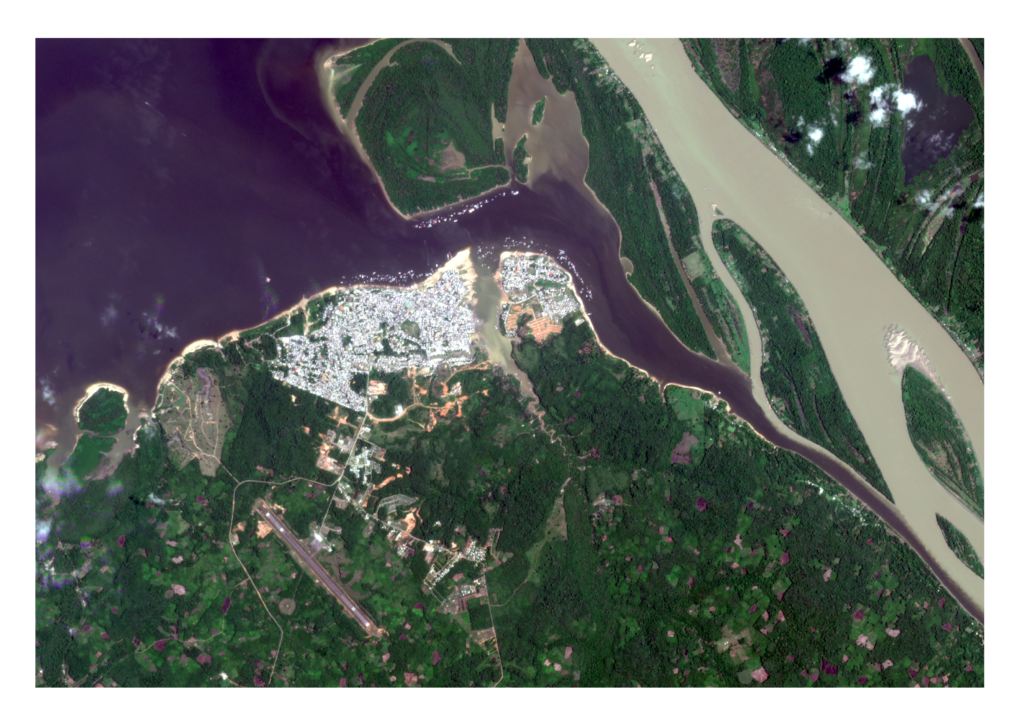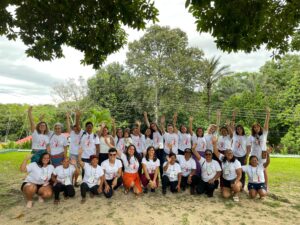By Thiago Sanna Freire Silva (University of Stirling, United Kingdom)
Translated by Bruna Favaro
A significant portion of Amazon is currently experiencing an extreme drought. On September 20th of this year, water levels at the monitoring station in Fonte Boa (AM) registered 1.7 meters below the average river level between 1979-2022¹ (Image 1). This level is practically the same as that observed during another extreme drought, in 1998. Several images and videos have been circulating through media and social media, showing isolated cities and communities, immobilized boats in completely dry riverbeds and a large mortality of fish and river dolphins. Dozens of municipalities have already declared a state of emergency², and the federal government is already studying measures to mitigate the impacts of the drought³.


Image 1. City of Tefé (AM) on September 19, 2021, a very close year to the historical average, and on October 9, 2023, during the current extreme drought. The brown and green areas in the 2023 image correspond to the exposed areas of the Tefé lake bed, where undergrowth develops during the drought. Source: Planet Education and Research Program: In Space for Life on Earth. https://api.planet.com.
Anyone who has spent some time in the Amazon region knows that the rivers, lakes and igarapés (streams) are the arteries of Amazon, connecting most of its more than 30 million inhabitants while transporting 20% of the entire planet’s freshwater volume. This vast and complex hydrological system also connects the enormous extensions of humid areas (floodplains, igapós and chacos) present in the Amazon basin, which cover an area equivalent to Chile⁴.
These areas are not only an essential element of biodiversity and carbon cycling in the Amazon, but also responsible for the provision of economic resources and ecosystem services for the majority of the Amazon population, especially in relation to fishing. To affect the annual pattern of flooding and drought in the Amazon in this way is to disrupt every aspect of human, animal and plant life in the region. And the drought does not only affect the aquatic systems. Many studies have shown how the extensive terrestrial forests that cover the Amazon basin are particularly dependent on the precipitation regime, and vulnerable to the effects of extreme events such as the drought that we have observed in recent weeks⁵.
Faced with such a scenario, three major questions arise: first, how extreme is this year’s drought situation? Second, what are its causes? And finally, what can we expect for the future in terms of similar extreme events?
The answers to these questions allow us not only to better understand the current events in the Amazon, but also reflect about the future of the world’s largest and most diverse humid tropical ecosystem.
We can start our answers from the causes: similarly to 1998, the large reduction in the volume of rainfall that has been taking place today in the Amazon is a result of what is known as El-Niño. This name is given to a phenomenon of excessive warming of the surface waters of the Pacific Ocean, which ends up affecting the circulation of winds, clouds and humidity throughout the world, but mainly in the Americas.
In Brazil, El-Niño events bring droughts to the North and Northeast regions of the country and intense rains to other regions. The reverse phenomenon (the cooling of the ocean surface), called La Niña, also causes reverse effects in the regions of the country. This makes sense, as it has to have a balance – the rain that stops falling in one place must necessarily precipitate somewhere else.
This year’s El Niño promises to be one of the most intense since 1950, with temperature anomalies of up to 5 degrees Celsius above average being observed. Similar intensities were observed during the years 2014-2015 and 1997-1998⁶, which also corresponds to historical droughts in the Amazon region. However, the temperature of the Pacific Ocean is not the only influence in Amazonian climate – two of the biggest droughts ever recorded (2005 and 2010) were primarily caused by the rising temperatures on the surface of the Atlantic Ocean, rather than the Pacific Ocean⁷.
This makes it clear that ocean temperatures across the globe directly affect rainfall, floods and droughts in the Amazon. In fact, extreme droughts were also observed during last year, also one of the greatest ocean warming years on record. When we note that oceans temperature has been continuously increasing over the past few decades, and that the year 2023 in particular is breaking the previous warming record by a large margin (Image 2), it becomes clear that we need to be seriously concerned about the Amazon’s climate future.

Now that we comprehend the causes of the current drought, we can answer the first question: how extreme is the current drought?
For this, let us take as an example again the data provided by the National Water Agency (ANA) for the fluviometric (river level) and pluviometric (rainfall) station in Fonte Boa (AM). Image 3 below shows river levels in every year since 1977, and we can see how the year 2023 compares to past extreme drought years (1995, 1998, 2005, 2010 and 2022), and to a “normal” year (2021).
This year’s drought is very similar to the 1998 one, both in terms of intensity and the speed and period of water descent. Regarding rainfall in Fonte Boa, the years 2010, 2022 and 2023 received, respectively, 20%, 29% and 42% less precipitation than the average expected for the period. This shows that the drought problem not only affects aquatic systems – where river levels depend on accumulated rainfall across the Amazon plain and Andes – but also terrestrial ecosystems and agriculture, which depend directly on local rainfall.

Finally, we can turn ourselves to the title question: can we still call these events “extreme”, or would this be a new normal brought by climate and environmental changes?
Three scientific studies can help us to comprehend this scenario. The study carried out by Jonathan Barichivich and collaborators in 2018⁸ shows that the frequency of extreme events (droughts and floods) increased from one to every seven years at the beginning of the century to one every two years in the last decade, with a more significant increase in frequency of extreme floods.
A study published this year by Ayan Fleischmann – coordinator of the Geospatial Analysis Group at the Mamirauá Institute for Sustainable Development in Tefé (AM) – shows that the extent of the flooded area in the Amazon has increased by 26% since 1980⁹. Another study, published in 2016 by Mino Sorribas and collaborators, had already predicted an increase of 30% up to 50% in the maximum discharge of rivers and an increase of 5% up to 10% in maximum flooded area in the east of the Amazon for the year 2100, with a decrease of the same magnitude for the west region¹⁰.
Yes, increases in flooded areas at the same time as increases in drought frequency appear to be contradictory results! However, it is important to highlight that the minimum and maximum levels of the Amazon rivers vary independently. Image 2 shows that the year 2022 exhibited both one of the lowest minimum levels (droughts) in history and one of the highest flood levels.
And the same study by Mino Sorribas shows that when we talk about minimum discharge and inundation (flooding), it is likely that discharge decreases between 20% and 50% by the year 2100 in almost all of the Amazon territory, with a corresponding reduction between 0 and 10% in flooded area. In addition, when we take into consideration that extreme flooding are as harmful as extreme droughts, the future scenario that emerges from these researches is indeed worrying; it becomes clear that the precipitation amplitude (difference between minimum and maximum levels in each year), river discharge and inundation (flooding) are continuously increasing, in a way that events previous regarded as “extremes” are now occurring almost every year – and new extreme events in this new regime are going to be even more intense.
This is the most important message of this discussion: the hydrology of the Amazon has already changed and continues to change, and public policies, management and planning strategies for the Amazon regions need to take into account that these extreme events are here to stay. For example, what will the impacts of implementing hydroelectric plants be like in the long term, when we know that these establishments further alter the ecological functioning of rivers¹¹? Long-term actions need to be thought about and discussed immediately, in all spheres and sectors of society, if we really hope to adapt to and minimize the impacts of this new reality. The alternative – an ecological and socioeconomic collapse of the Amazon – is simply unthinkable.
___________________________________________________________________________
About the author: Thiago Sanna Freire Silva is a lecturer at the University of Stirling, in the United Kingdom, and studies the influence of the spatio-temporal dynamics of the landscape on ecological processes, as well as the possible effects of climate change and anthropogenic activities on the distribution, structure, diversity and phenology of plant communities.
___________________________________________________________________________________________
¹According to data obtained from the telemetry system of the National Water Agency (ANA) on 09/21/2023. Due to a recent cyber attack on ANA’s online data distribution platform, it was not possible to obtain more recent data for this article.
²https://agenciabrasil.ebc.com.br/geral/noticia/2023-10/sobe-para-23-total-de-cidades-em-situacao-de-emergencia-no-amazonas
³https://agenciabrasil.ebc.com.br/geral/noticia/2023-10/alckmin-e-ministros-vao-manaus-discutir-medidas-contra-seca-extrema
⁴Fleischmann, A. S. et al. (2022). How much inundation occurs in the Amazon River basin? Remote Sensing of Environment, 278, 113099. https://doi.org/10.1016/j.rse.2022.113099.
⁵Tavares, J. V. et al (2023). Basin-wide variation in tree hydraulic safety margins predicts the carbon balance of Amazon forests. Nature, 617(7959), Article 7959. https://doi.org/10.1038/s41586-023-05971-3
⁶https://origin.cpc.ncep.noaa.gov/products/analysis_monitoring/ensostuff/ONI_v5.php.
⁷Marengo, J. A., Tomasella, J., Alves, L. M., Soares, W. R., & Rodriguez, D. A. (2011). The drought of 2010 in the context of historical droughts in the Amazon region. Geophysical Research Letters, 38(12). https://doi.org/10.1029/2011GL047436.
⁸Barichivich, J. et al. (2018). Recent intensification of Amazon flooding extremes driven by strengthened Walker circulation. Science Advances, 4(9), eaat8785. https://doi.org/10.1126/sciadv.aat8785.
⁹Fleischmann, A. S., et al. (2023). Increased floodplain inundation in the Amazon since 1980. Environmental Research Letters, 18(3), 034024. https://doi.org/10.1088/1748-9326/acb9a7.
¹⁰Sorribas, M. V., et al (2016). Projections of climate change effects on discharge and inundation in the Amazon basin. Climatic Change, 136(3), 555–570. https://doi.org/10.1007/s10584-016-1640-2
¹¹Schöngart, J. et al. (2021). The shadow of the Balbina dam: A synthesis of over 35 years of downstream impacts on floodplain forests in Central Amazonia. Aquatic Conservation, 31(5), 1117–1135. https://doi.org/10.1002/aqc.3526





